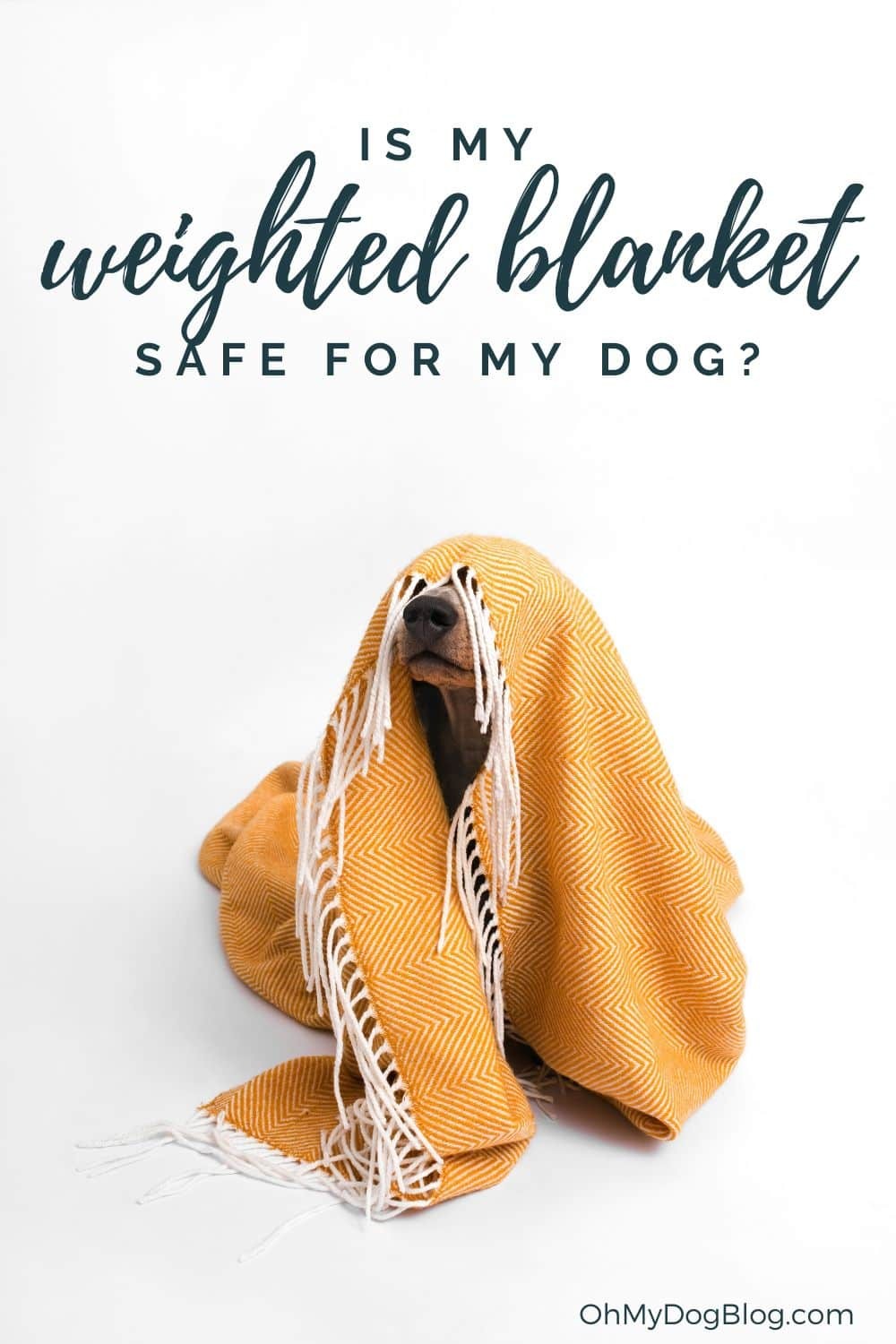Every night, after a long day, many people find comfort in winding down with a good book or TV show under a weighted blanket. The gentle pressure is known for its calming effects, helping to ease anxiety and promote restful sleep. If you’re a pet owner, especially a dog parent, you might have noticed your furry friend trying to snuggle under your weighted blanket. This might lead you to wonder: Are Weighted Blankets Safe For Pets?
 A dachshund puppy peeks out from under a yellow chevron weighted blanket, representing the question of whether weighted blankets are safe for pets and dogs.
A dachshund puppy peeks out from under a yellow chevron weighted blanket, representing the question of whether weighted blankets are safe for pets and dogs.
It’s a valid concern. While these blankets are increasingly popular for humans, applying the same logic to our animal companions requires careful consideration. Let’s delve into the world of weighted blankets and explore their safety and potential benefits for pets.
How Weighted Blankets Work: The Science of Deep Pressure Stimulation
Weighted blankets work by utilizing what’s known as deep pressure stimulation (DPS). This therapeutic technique involves applying gentle, distributed pressure to the body. Imagine the feeling of being hugged or swaddled – that’s similar to the sensation a weighted blanket provides.
This pressure has a profound effect on the nervous system. According to Penn Medicine, DPS can help reduce anxiety, manage symptoms of ADHD, improve sleep disorders, and offer comfort to individuals with autism. Researchers at UCLA Health have also highlighted benefits such as easier sleep onset, reduced nighttime awakenings, and an overall increased sense of calm in adults using weighted blankets for sleep issues related to depression and anxiety. UCLA Health notes these positive impacts on sleep quality and anxiety reduction.
These blankets typically contain plastic or glass beads to achieve their weight, which can range from 5 to 30 pounds for adult blankets. The weight is evenly distributed to provide that consistent, comforting pressure. The appeal is clear: they offer a non-pharmacological way to soothe the nervous system and promote relaxation.
Are Weighted Blankets Actually Safe for Pets?
When it comes to our pets, particularly dogs and cats, the question of safety is paramount. Currently, there’s a lack of extensive peer-reviewed research specifically focusing on weighted blankets for pets. However, we can draw conclusions based on our understanding of how these blankets work and apply general pet safety principles.
The consensus among many pet experts and anecdotal evidence suggests that weighted blankets can be safe for pets when used correctly and with supervision. The key lies in ensuring the blanket’s weight is appropriate for the animal’s size and that the pet can move freely underneath it.
It’s also worth noting that the concept of deep pressure therapy isn’t entirely new to the pet world. Products like the ThunderShirt and other compression vests have been used for years to help calm anxious dogs, leveraging similar principles of gentle, constant pressure.
Potential Benefits of Weighted Blankets for Anxious Pets
Just like humans, pets can experience anxiety for various reasons, including loud noises like thunderstorms or fireworks, separation anxiety, travel stress, or general nervousness. Weighted blankets can potentially offer a drug-free way to alleviate some of this anxiety in pets.
The deep pressure from a weighted blanket is thought to increase serotonin levels (the “feel-good” hormone) and decrease cortisol levels (the stress hormone) in both humans and animals. This biochemical shift can lead to a calmer, more relaxed state. Many pet owners who have used weighted blankets for their anxious pets report seeing positive changes in their pet’s behavior, such as reduced panting, pacing, and restlessness.
Choosing the Right Weight: Safety First
Selecting the appropriate weight is crucial for pet safety. The general guideline for humans is to choose a blanket that is about 5 to 12% of their body weight. For pets, it’s generally recommended to err on the lighter side.
Start with a very light blanket and observe your pet’s reaction. The blanket should never be so heavy that it restricts the pet’s movement or makes it difficult for them to breathe or get out from under it. For smaller pets, or breeds with breathing sensitivities like brachycephalic breeds (e.g., Bulldogs, Pugs, Shih Tzus), extra caution is needed. Consulting with your veterinarian before using a weighted blanket is highly recommended, especially for these breeds or pets with pre-existing health conditions.
Never force your pet to stay under a weighted blanket if they seem uncomfortable. Always ensure they have the ability to easily get out from underneath the blanket whenever they choose.
Important Safety Precautions
While weighted blankets can offer benefits, several safety measures must be taken:
- Supervision is Key: Always supervise your pet when they are using a weighted blanket, especially initially. Never leave a pet unattended under a weighted blanket for extended periods.
- Avoid Overheating: Ensure the blanket is breathable and doesn’t cause your pet to overheat, particularly in warmer climates or for breeds prone to heat sensitivity.
- Chewing Hazard: Be aware that some pets might chew on the blanket, especially if left unsupervised. The small beads inside can be a choking hazard and potentially toxic if ingested in large quantities (though typically non-toxic glass or plastic). If your pet is prone to chewing, monitor them closely and consider a blanket with a durable, chew-resistant cover.
- Entrapment Risk: Ensure the blanket isn’t too large or heavy that it could potentially trap or suffocate a small pet. It should be appropriately sized for your pet.
- Respiratory Distress: Avoid using weighted blankets on brachycephalic breeds or pets with respiratory issues without veterinary guidance, as the added weight on their chest could potentially exacerbate breathing difficulties.
When Weighted Blankets Might Not Be Suitable for Pets
In certain situations, weighted blankets may not be appropriate or safe for pets:
- Puppies and Senior Pets: Very young puppies and frail senior pets might not have the strength to move freely under a weighted blanket, increasing the risk of entrapment or overheating.
- Brachycephalic Breeds and Respiratory Issues: As mentioned, breeds with breathing difficulties and pets with pre-existing respiratory conditions should be evaluated by a vet before using a weighted blanket.
- Pets Uncomfortable or Resistant: If your pet shows signs of distress, discomfort, or actively tries to avoid the blanket, do not force them to use it.
- Crated Pets: Never place a weighted blanket in a crate with an unsupervised pet.
Choosing a Pet-Safe Weighted Blanket
If you decide to try a weighted blanket for your pet, consider these features:
- Washable and Durable: Opt for a machine-washable blanket or one with a removable, washable cover for hygiene and easy cleaning. Pet-friendly blankets should be durable enough to withstand potential scratching or chewing.
- Appropriate Weight and Size: Choose a blanket specifically designed for pets or a lightweight blanket suitable for their size. Start with a lighter weight and observe their reaction.
- Breathable Materials: Look for blankets made from breathable fabrics to prevent overheating.
- Quality Construction: Ensure the blanket is well-constructed with secure stitching to minimize the risk of bead leakage.
While there aren’t as many “pet-specific” weighted blankets readily available as human ones, you can often use lightweight human-sized weighted blankets or smaller, child-sized versions, as long as you prioritize safety and appropriate weight. You can find various options online retailers like Amazon and marketplaces with handmade goods like Etsy, searching for “lightweight weighted blanket” or “child weighted blanket.”
Conclusion: Proceed with Caution and Observation
Weighted blankets hold potential benefits for anxious pets, offering a natural way to promote calm and relaxation through deep pressure stimulation. However, safety should always be the top priority. Careful selection of weight, constant supervision, and awareness of potential risks are essential when considering weighted blankets for pets.
If you’re thinking about using a weighted blanket for your furry friend, especially if they have anxiety or sleep issues, consult with your veterinarian first. They can provide personalized advice based on your pet’s breed, health, and individual needs. When introduced responsibly and cautiously, a weighted blanket might become a valuable tool in your pet care toolkit, offering comfort and security to your beloved companion.
